Were Vikings in South America Over 400 Years Before Columbus?
Here is presented the widely dismissed account that probably sometime in the mid-11th century, Danish Vikings from Schleswig and the Danelaw (as ascertained from runic rock inscriptions) arrived at Santos in Brazil and proceeded inland to Paraguay. From a fortified hill near the Brazilian border, they occupied a defensive position for some part of two centuries, keeping watch on a nearby small mountain. It has been reported that in the 20th century, beneath the mountain under observation, was discovered a large area whose walls and roof are built of concrete unknown to science and cannot be opened but are believed to conceal a network of tunnels. The following unravels the story presented by just a few advocates, of Vikings in South America. Like so many of these tales, it needs further investigation to enable verification, but nonetheless, it provides food for thought.
The Vikings in South America
Academic historians generally do not admit the presence of European visitors to South America until after the arrival of Christopher Columbus. Therefore for them, all talk of Vikings travelling anywhere south of Nova Scotia before 1492 AD is not even hypothetical but pure fiction. In order to maintain this pretense, historians have found it necessary to discard what might be to others common sense and replace it with a preposterous theory. The best example of this is: The Case of the Bundsö Sheepdogs .
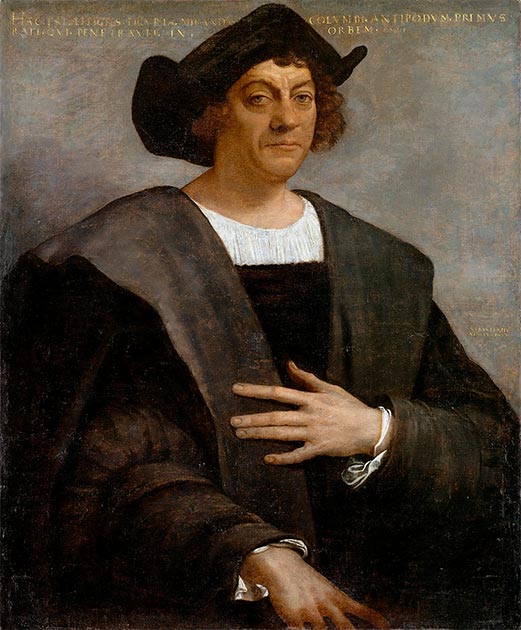
Were Vikings in South America before Christopher Columbus? Pictured: posthumous portrait of Christopher Columbus. (Sebastiano del Piombo / Public domain )
It was the custom of the pre-conquest Incas to be mummified with their dogs. A variety of dogs found in graves at Ancon, Chile, by Professor Nehring in 1885 was analyzed by two French zoologists in the 1950s who determined that this variety could not be descended from the wild dogs of South America. They matched them to Canis familiaris L.patustris Rut of which numerous skeletal remains have been discovered, all at Bundsö on the Danish island of Als/Jutland.
The anatomical coincidence being deemed perfect, the difficulty then lay in accounting for how these Danish dogs got to South America before the Spanish Conquest . The French scientists got their heads together and decided that: “the Danish Vikings must have given some of their Bundsö sheepdogs to Norwegian Vikings who took them to Vinland. When the Norwegians were ejected from Vinland by the natives, the dogs must have been carried from Vinland to modern Canada where they must have been passed from hand to hand ever southwards by tribes which did not want them, involving travel by land and sea and then climbing mountains into Peru where they were adopted by the Incas.”
This nonsensical explanation was the only scientific theory available, that is, that would fit with the accepted history of the finding of the Americas. But if that account were wrong, a more common sense explanation might be that the Danish Vikings brought the dogs with them when they sailed to South America from Europe in the eleventh century.
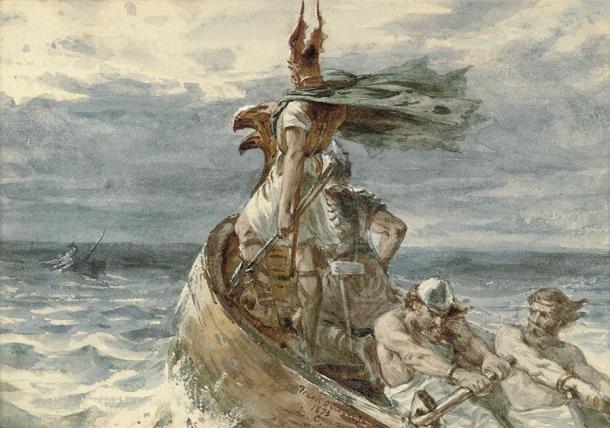
Depiction of a Viking and his men heading to land. (Frank Dicksee / Public domain )
The Viking Protectorate in Paraguay?
In 1085 AD, King Knut II had 1700 ships for the “western expansion”. For the greater distances involved, a special type of woolen sail, which had been developed for greater speed and sailing much closer to the wind, as proved in experiments by Amy Lightfoot with the Viking Ship Museum, Roskilde. Strangely for Europeans so far from home in the 11th century, the Danish-Schleswig Vikings in this account seemed to know exactly where they were heading.
They came ashore at Santos, Brazil, found the path which had been long previously prepared, and made their way on foot to uplands located at Amambay, 25 kilometers (16 mi) south-east of the modern town of Pedro Juan Caballero in Paraguay.
The Cerro Corá is a ring of three small mountains five kilometers (3 mi) across. Three kilometers (1.9 mi) north of this ring is the mountain Itaguambype , which means ‘fortress’. Long before the supposed arrival of the Vikings, it had been hollowed out to make one, hence its name.
The anthropologist who investigated the area in the 1970s, Jacques de Mahieu, was a French – Argentinian anthropologist and leader of the Spanish neo-Nazi group CEDADE, who has proposed various Pre-Columbian contact theories, and claimed that certain indigenous groups in South America are descended from Vikings. Through his observations, he decided that, at some indefinite time in the past, the construction’s purpose must have been some kind of military observation post large enough for a settlement or a refuge.
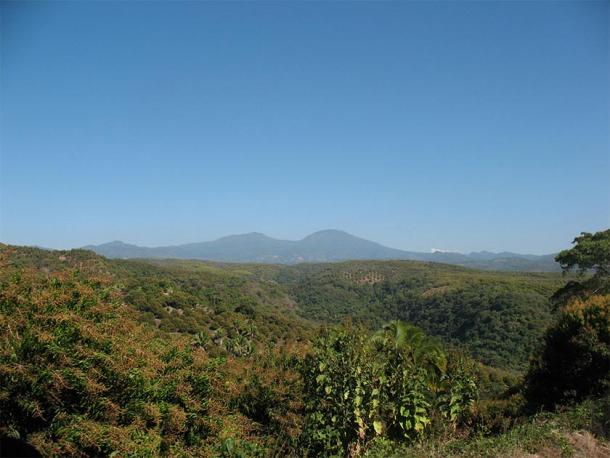
Cerro Corá national park in modern day Paraguay, the site where the Danish Vikings in South America were once believed to hold a settlement. (Christian Frausto Bernal / CC BY-SA 2.0 )
The low mountain Itaguambype lies on a north-south axis. It is two kilometers (1.2 mi) in length and one hundred meters (328 ft) high. The ex-fortress is a section cut off at the south end, 300 meters (984 ft) long with a 20-meter-wide (66-ft) opening for access. The sides are of natural rock, a quarter of the way up from the ground with above it blocks of unequal-size, stone tailored to fit together perfectly smoothly in the manner similar to anti-earthquake walls in Peru and Bolivia.
Along the crest a 3-meter-wide (10-ft) flat path runs; at the southern extremity is a platform with the ruins of a round lookout tower raised 5 meters (16 ft) above the crest for a panorama of the entire territory but particularly Cerro Corá. The fortress would have been abandoned either in about 1250 AD, when a native rebellion succeeded in expelling the Vikings, or earlier, once it had served its true purpose.
Of additional interest in the area is the Norse temple at Tacuati excavated in the 1970s, and the fact that the total of engraved runic inscriptions in Paraguay runs in the thousands and exceeds that of all Scandinavia: 71 have been translated from the South American Futhorc dialect. One 5-letter runic inscription was found inside Itaguambype but has defied translation.
700 Years Later – Fritz Berger Investigates
Fritz Berger was a 50-year-old mechanical engineer, a native of what was then the Sudetenland. He admitted that he suffered mental disturbances from time to time. He wandered South America doing odd jobs, and during the War of the Chaco between Paraguay and Brazil in 1932-1935 served the Paraguayan Army in one of their workshops reconditioning captured enemy weapons. From 1935 until 1940 he stated that he prospected unsuccessfully for oil deposits in the Brazilian State of Paraná, but more likely in this period he gathered the information leading to the investigation which followed.
In February 1940, Berger crossed into Paraguay at the Pedro Juan Caballero border post and contacted the Army of Paraguay. Simply as a result of what he told them, they agreed to form a company with him known as Agrupación Geológica y Archaeológica (AGA). A clause in the agreement stipulated that the treasure trove was the property of Paraguay. The Paraguayan signatory was Major Samaniego, later the Paraguayan Minister of Defense.
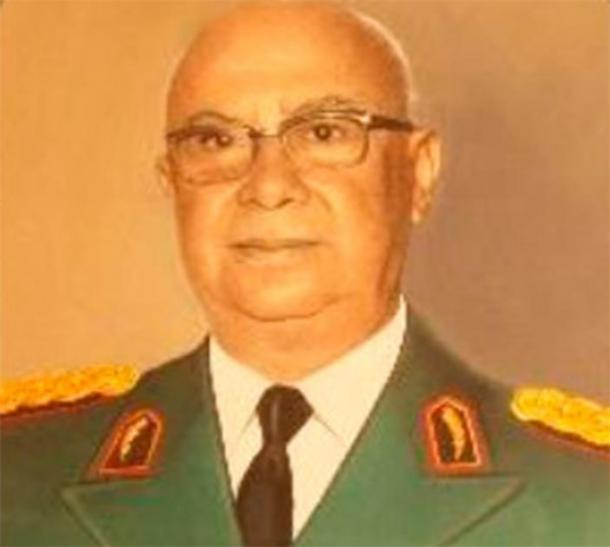
Major Samaniego of Paraguay pictured in 1948, the military official who helped Fritz Berger in his investigation of Vikings in South America . ( Public domain )
At the heart of this contract was the Legend of the White King of Amambay. The tradition relates:
“In those days there reigned in this region a powerful and wise king called Ipir. He was white and wore a long blond beard. With men of his race and Indian warriors loyal to him, he lived in a community situated on the crest of a mountain. He possessed fearsome weapons and had immense riches in gold and silver. One day however he was attacked by savage tribes and disappeared for ever. That is what my father told me, who had heard it from his father.”
The reader should note here that King Ipir was never identified, and his followers “disappeared” and there is no suggestion that they were massacred.
Berger had a female correspondent in Munich to whom he wrote occasionally describing the developments in Paraguay, possibly for passing on to the German government, and copies of these letters passed into the possession of de Mahieu much later for inclusion in his book. In May 1940 Berger wrote to Munich mentioning that he knew of tunnels in the Cerro Corá area “130 kilometers long” (81 mi). By October 1941, he had drawn up a plan of the subterranean installations and sketches of four tunnels, including careful measurements but insufficient information to identify the locations of the various entrances.
The Mysterious Bald Mountain and Impenetrable Slab
On another day in 1940, based on mysterious information he probably brought with him from Brazil, Berger “happened to notice” a great rock forty meters (131 ft) in height in the direction ten kilometers (6 mi) south-south-east of Cerro Corá. The rock was in two parts and covered in dense vegetation halfway up. For this reason the natives called it Yvyty Pero – “Bald Mountain”.
Berger’s secret reasons for wanting to dig there convinced Major Samaniego to set up a permanent military encampment with wooden houses within twenty meters (66 ft) of Bald Mountain, and he also renamed the range of hills “Cerro Ipir”. Once his sappers began excavating, to their surprise they reportedly found “a piece of gold in a triangular shape, which appeared to be the broken corner of a table” and “a walking stick with a gold head.”
After that the rainy season set in, impeding progress by flooding: the excavation was suspended once all explosives available could not damage a great slab of reinforced concrete encountered at the level of the mountain floor eighteen meters (59 ft) down. At this point, de Mahieu leaves us guessing what happened next in the year from “the end of 1941” until “the end of 1942” during which time the Third Reich became involved and appears to have agreed to send to Paraguay a special kind of pneumatic drill. We know this because in November 1942, US agents reported to their naval attaché at Montevideo the arrival of a German U-boat at the Argentine naval base of Bahia Blanca and this coincided with the unexplained visit there by Major Pablo Stagni, Commander-in-Chief of the Paraguayan Air Force, known to the Americans as the German agent “Hermann.”
Following this ‘coincidence’, according to Berger, in December 1942 work at Bald Mountain resumed. The Paraguayan sappers worked into the mountainside obliquely to connect with the vertical shaft. At 23 meters (75 ft), they encountered again the huge slab of concrete, which could not even be scratched by the drill or explosives and was now described as “a definitely artificial material harder than reinforced concrete and unknown to science.” After further attempts in 1944 were thwarted for the same reason, the excavation was abandoned. Fritz Berger died in Brazil in 1949. This part of Amambay is inaccessible today as a military area.
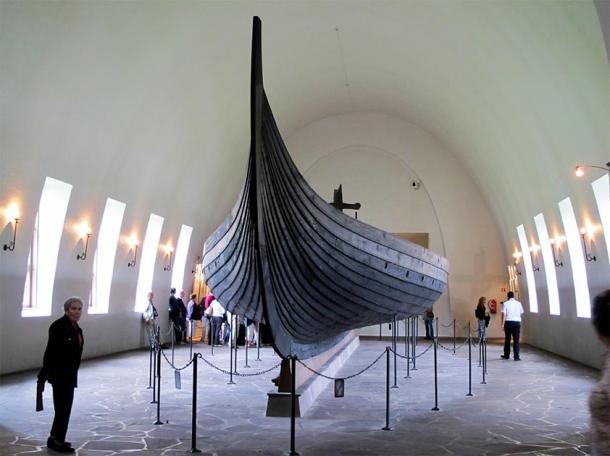
Viking ship from the Ship Museum in Oslo. (Alex Berger / CC BY-NC 2.0 )
Conclusion
So, to tie together this theory, using legend, possible runic evidence, and Nazi involvement, long before the 11th century, the rich and powerful white king Ipir and his followers, unknown to the world’s historians, inhabited the crest of the mountain fortress Itaguambype. When attacked by an overwhelmingly superior force of natives, Ipir and his court retired to safety below Bald Mountain. Perhaps the Vikings were sent to Amambay later to protect and oversee the installation of the impenetrable concrete roof and sides over the portal below Bald Mountain.
What is interesting about this story is that all the main actors are hiding something. All academic historians and scientists, some knowingly, adhere to the apparent lie that no European reached southern America before Columbus in 1492. Therefore, “no Vikings could have been there”. Fritz Berger never revealed the source of his information about Bald Mountain and the network of tunnels extending cross-country from beneath it, but when he crossed into Paraguay from Brazil he knew for sure exactly where he was going and so did the Paraguayan Army.
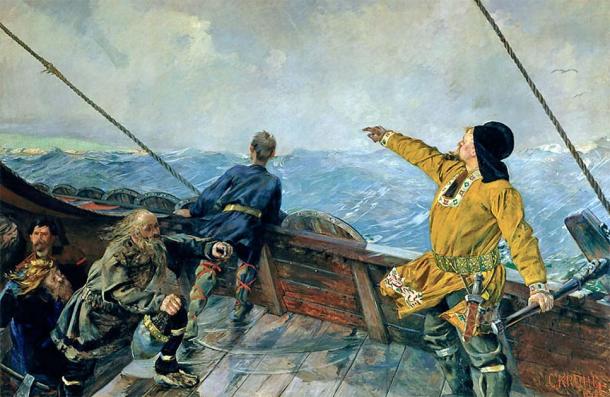
Depiction of the first Vikings arriving in the Americas. (Christian Krohg / Public domain )
The author, anthropologist/archaeologist Jacques de Mahieu, an outcaste from the scientific fraternity for having been an officer in the French Waffen-SS Division, perhaps revealed much ‘hidden history’, they would prefer he had not mentioned. Decades after the war, the SS oath he had sworn bound him, and there were still official German secrets with regard to which he was obliged to remain silent. Therefore in his book, he omitted any mention of the year 1942 and details of where the pneumatic drill had come from.
The Third Reich was in the middle of a major war, which it was already in danger of losing. Its outcome depended on the Battle of the Atlantic, yet they could spare a U-boat to detour to Argentina with a pneumatic drill for an archaeological dig in Paraguay. Probably they did not care two hoots for King Ipir and so their interest was in two things:
(i) They needed the tiniest chip of the reputedly impenetrable concrete roof and walls of the underground refuge for scientific analysis to obtain the formula.
(ii) They needed to know where the tunnel beneath Bald Mountain led? Was the mountain one of the portals into the Vril world or similar?
Top image: Representation of Vikings in South America. Source: Nejron Photo / Adobe stock
References
de Mahieu, J. 1970. El Rey Vikingo del Paraguay . Hachette.
Friant, M. 1955. Du chien néolithique de Bundsö au chien des Vikings et des Incas . Muséum de Paris, Zurich.
Friant, M. 1964. Le chien des Incas précolombien . n.p., Paris.
Friant, M. & Reichlen, H. 1950. Deux chiens prehistoriques du désert d’Atacama. n.p., Lima.
Nehring, A. 1955. Über alt-peruanische Hundermummien . n.p., Berlin.
Newton, R. 1998. Actividades clandestinas de la armada alemana en aguas argentinas. CEANA report to the Argentine Government, February (main text at level of footnote 27).
Geoffrey
Geoffrey Brooks is a UK pensioner 76 years of age. He is not an academic. Since having his first book published in the 1990’s he authored two more, and has translated about ninety military memoirs and political-historical books from the German. Read More
Comments
Columbus never reached what is today known as South America, his own logs of his 4 recorded voyages shows this fact clearly, so why is this still a statement being used as a historical fact when it is not? I is promoting false information, these logs are pertenant and define the areas he actually visited.
I find it absolutely amazing! Seems after mine went to Peru, they came back to Europe, had a stop in Mexico, and Puerto Rico, went on to Italy. Came back to Europe and went to India two times coming back both times. Seems our ancestors did more traveling than we thought possible!
I just had a Mitochondrial DNA test. it revealed that I carry the Peruvian chromosome of an ancestor who lived around 1175 AD, 33 generations past, and as early as 6 generations back 1820- 1860 and a few other Pervian ancesters in between. interestling enough I also have Northern European which would fall in line with Viking ancestry 795 – 855 AD, 47 generations back. I was stuck for a few hours trying to figure out how in the world do I have Peruvian, Mexican, Columbian and Purto Rican in my DNA, then I found this article. I’m convinced that my Viiking Ancestors made contact nearly 400 years before Columbus and the Spanish. Hell, I’m living proof!
Interesante artículo, pero creo que se están confundiendo los términos, no se trata de quien llegó primero al Nuevo Mundo. Seguramente quienes primeros llegaron a América fueron los Amerindios en la Cuarta Glaciación de Würz cuando bajó el nivel del mar y entonces pudieron pasar a pie desde Siberia a América siguiendo la caza. Hay muchas teorías que hablan de que pudieron llegar los Sumerios, estos tienen muchas posibilidades, también se habla de Chinos, Fenicios, Griegos, Romanos, etc.. Pero insisto se confunden los términos. Si vamos al Diccionario de la Real Academia Española y buscamos la palabra “Descubrir”, vemos que aparecen las siguientes acepciones: “1º . Destapar”. “2º. Dar a conocer”..Pues ese precisamente es el mérito de Cristobal Colón, que dió a conocer al entonces mundo conocido (Europa, Asia, África) la existencia de un nuevo continente, América; hasta ese momento desconocido. Y, desde ese mismo momento quedó incluido en el mundo conocido. Los demás pudieron haber llegado antes a América, pero, no lo dieron a conocer al resto del mundo conocido. Por favor, a Cristobal Colón, se le conoce no como el primero que llegó a América, sino, “EL QUE LA DIÓ A CONOCER”.
Follow the Paths of Viking Raiders from Norway to North America

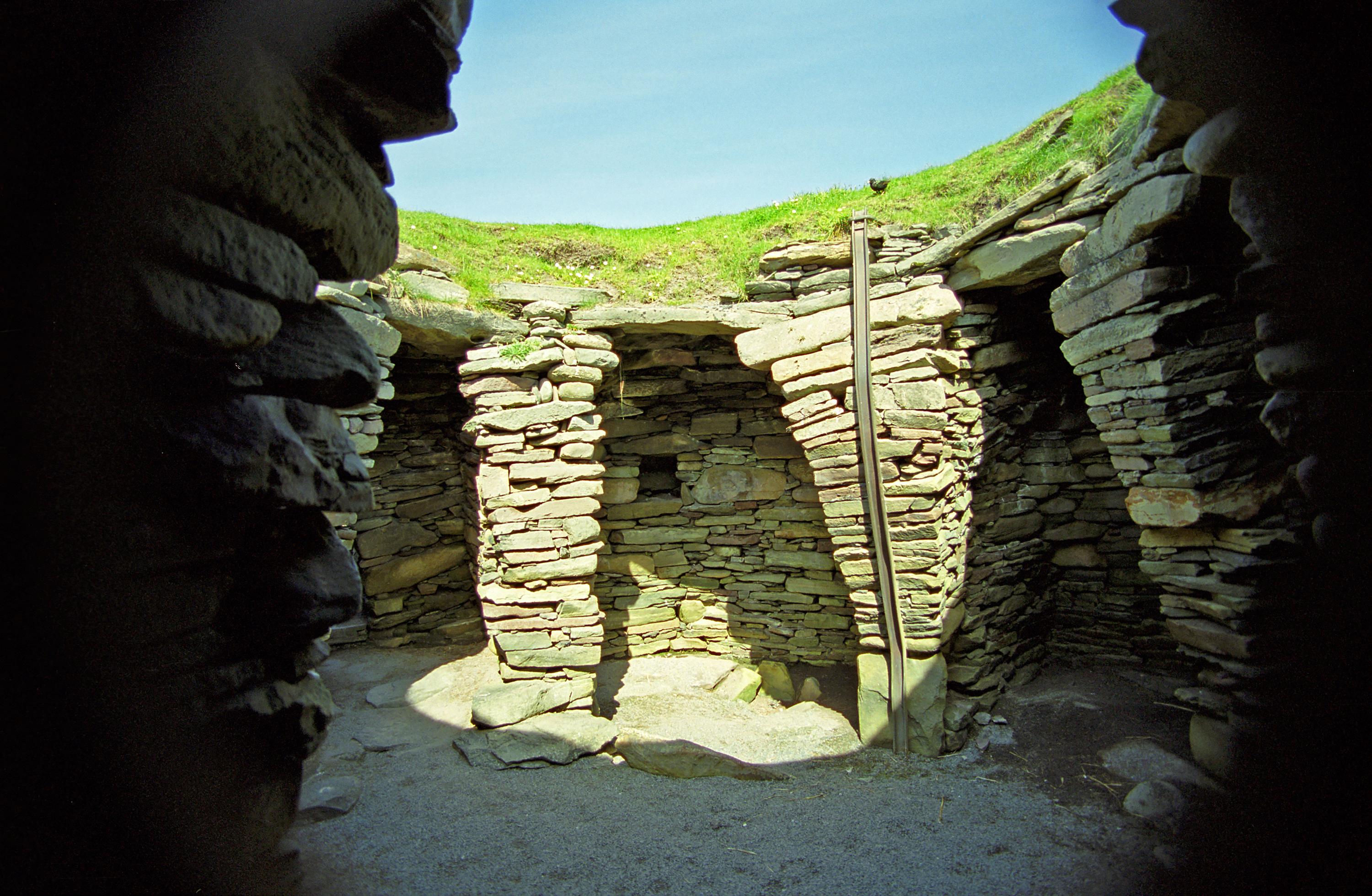
nyiragongo / iStock
From 793 to 1066 CE, hearing the words “Viking” or “Norsemen” would put just about anyone on edge. The group was notorious for sailing their longboats into harbors and viciously attacking the people there—stealing all the available loot, taking slaves and killing just about everyone else. But this bad behavior tells only part of the Viking story. “All Vikings were Norsemen, but not all Norsemen were Vikings,” historian and Viking Cruises lecturer Patrick Goodness told Smithsonian.com. “They became Vikings when they went out plundering; they went viking, as a verb.” Eventually, the term morphed into a classification for the entire community.
Both sides of the population, though, were inspired by the same sentiment: to go out and find new land. Some wanted to explore and plunder, but others simply wanted to discover more fertile lands to farm and settle peacefully, moving ever westward from Europe toward North America in search of the perfect spot. They traveled by longboat as the crow flied, settling in several distinct paths we can still track today.
So grab your helmet and shield and hop on a boat—now you can follow one of those paths of Viking Norsemen, from their original settlement in Norway across the Atlantic to their first settlement in North America.
Norway
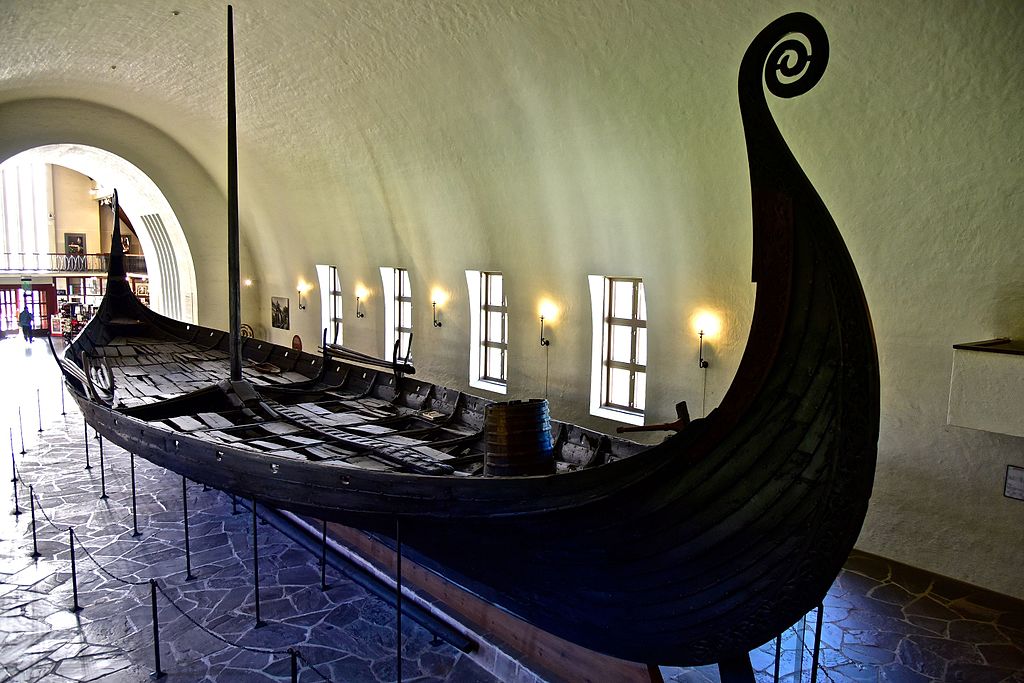
The Oseberg Ship at the Viking Ship Museum in Oslo. Creative Commons
Since the beginning of the Viking age, the group of settlers and raiders ruled the western coast of Norway and much of Scandinavia. The Norwegian Vikings were among the most adventurous, sailing and plundering along their path to North America long before Columbus arrived at the continent’s shores. Here, in seaside towns like Bergen and Stavanger, once a major Hanseatic League trading port, the Vikings built their longships that would take them around the world.
What to see: The Bergen Maritime Museum has a selection of Viking longship models, but to see the real thing, head to the Viking Ship Museum in Oslo, which has the three best-preserved ships that have been found to date. For a decidedly more modern sight, head a bit south of Stavanger to see three gigantic metal Viking swords sticking up from the shoreline. The monument, unveiled in 1983 by King Olav, commemorates Viking King Harald Fair Hair’s success at uniting the three kingdoms of Norway into one unit.
Shetland Islands, Scotland
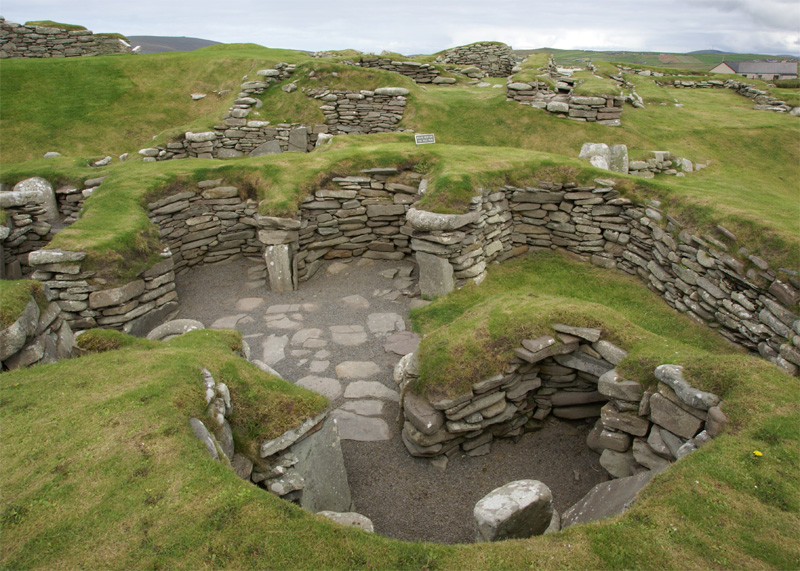

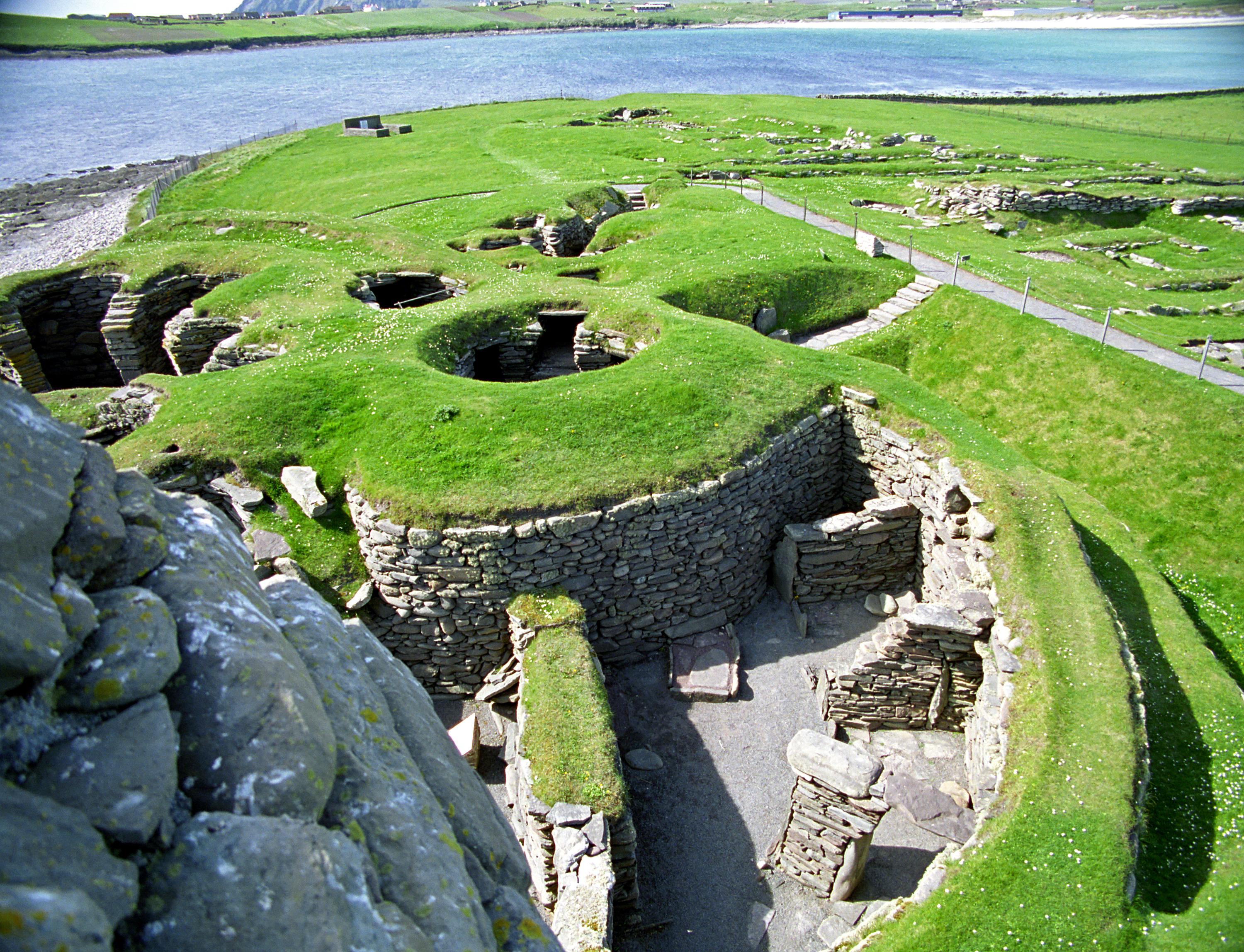
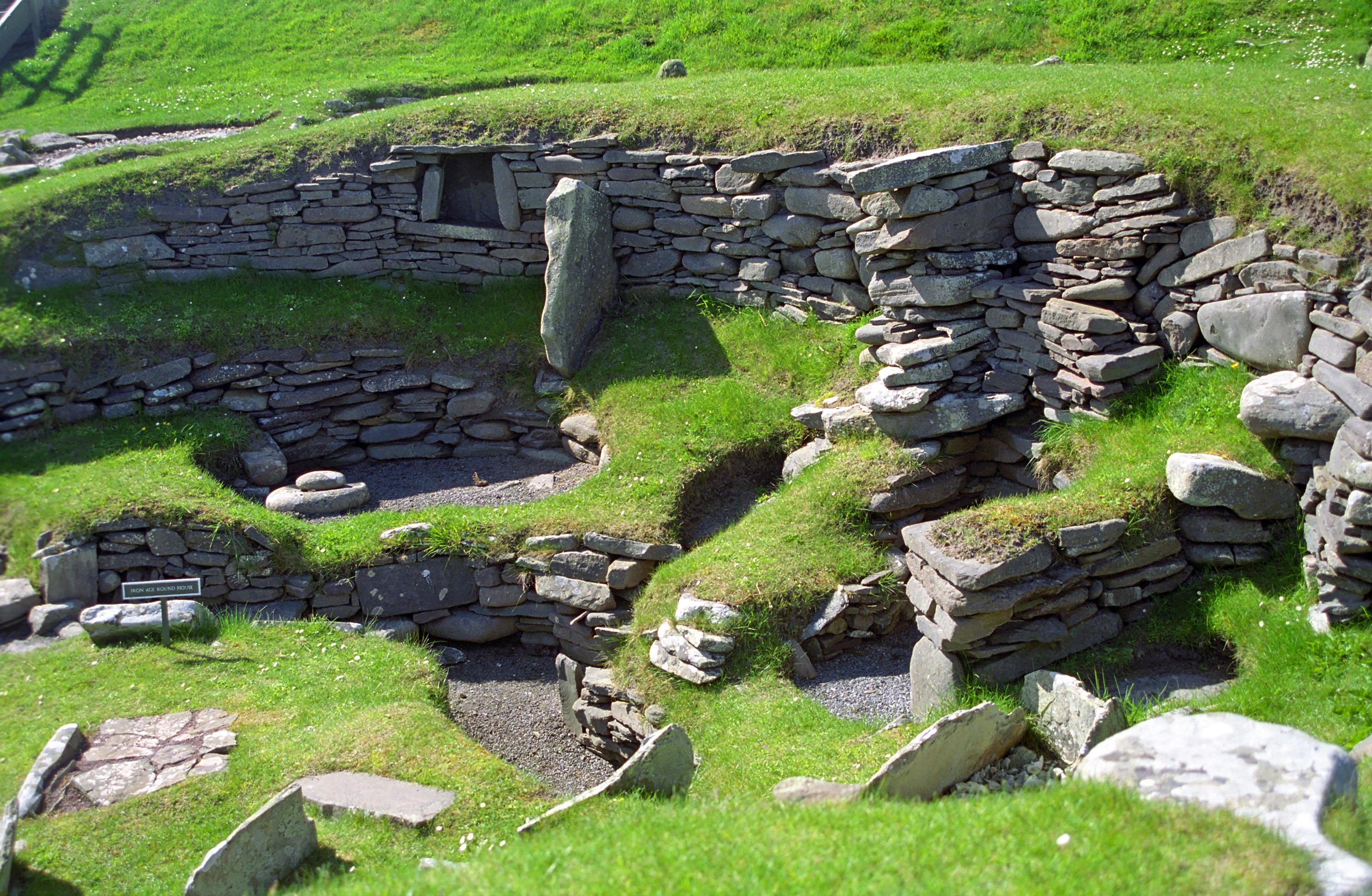
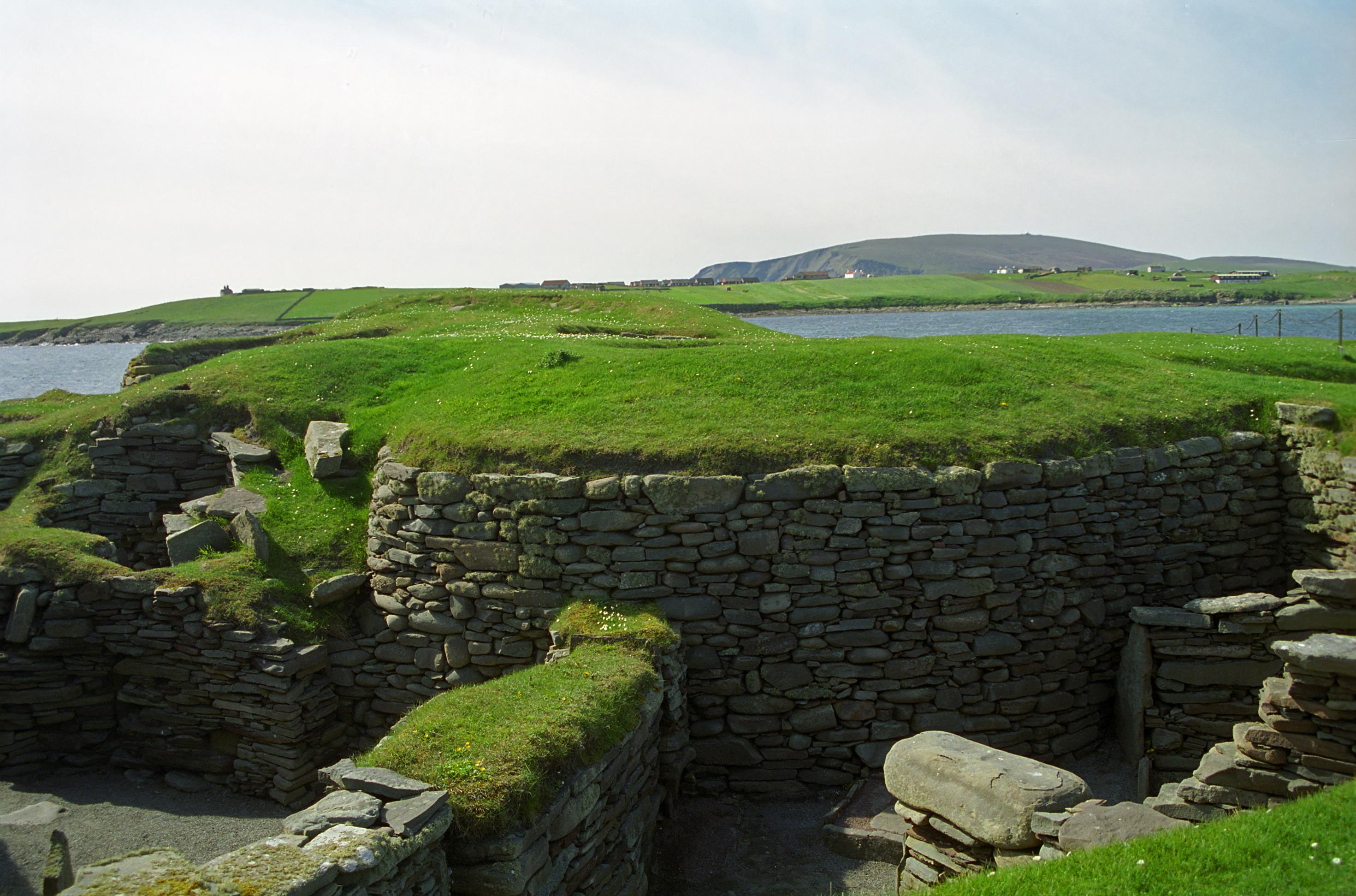
The Vikings arrived in Shetland around 850, and the Norse influence can still be seen today throughout the area; in fact, 95 percent of the place names in the Shetland Isles are still the original Old Norse names. More than 30 archeological sites on Unst Island alone hold evidence of Viking homes and settlements. Even the dialect of present-day Shetland residents has a healthy sprinkling of Old Norse words leftover from Viking rule. And, depending on who you ask, you may be able to get a ride out to Tingwall Valley, where the Vikings held their parliamentary sessions on a small peninsula in a lake.
For the next 600 years after arrival, Vikings and Norsemen ruled the Shetland Islands. But in the late 1400s (after many Vikings had already sailed on to greener pastures in different countries), Norse rule abruptly ended; the Shetland Islands became officially Scottish as part of a marriage treaty between a Scottish prince and a Danish princess.
What to see: Jarlshof on Mainland Shetland is one of Scotland’s biggest archeological sites, a huge complex documenting more than 4,000 years of settlement on the islands. Not only will visitors find ruins of a Viking longhouse, but they’ll also explore Neolithic homes, Bronze and Iron Age settlements, medieval farmsteads, and a laird’s house from the 1500s. And don’t miss Up Helly Aa in Lerwick, among the largest fire festivals in Europe. Viking descendants follow a Viking longship in a huge procession, all carrying torches, and at the end of the route, the boat is set on fire.
Faroe Islands
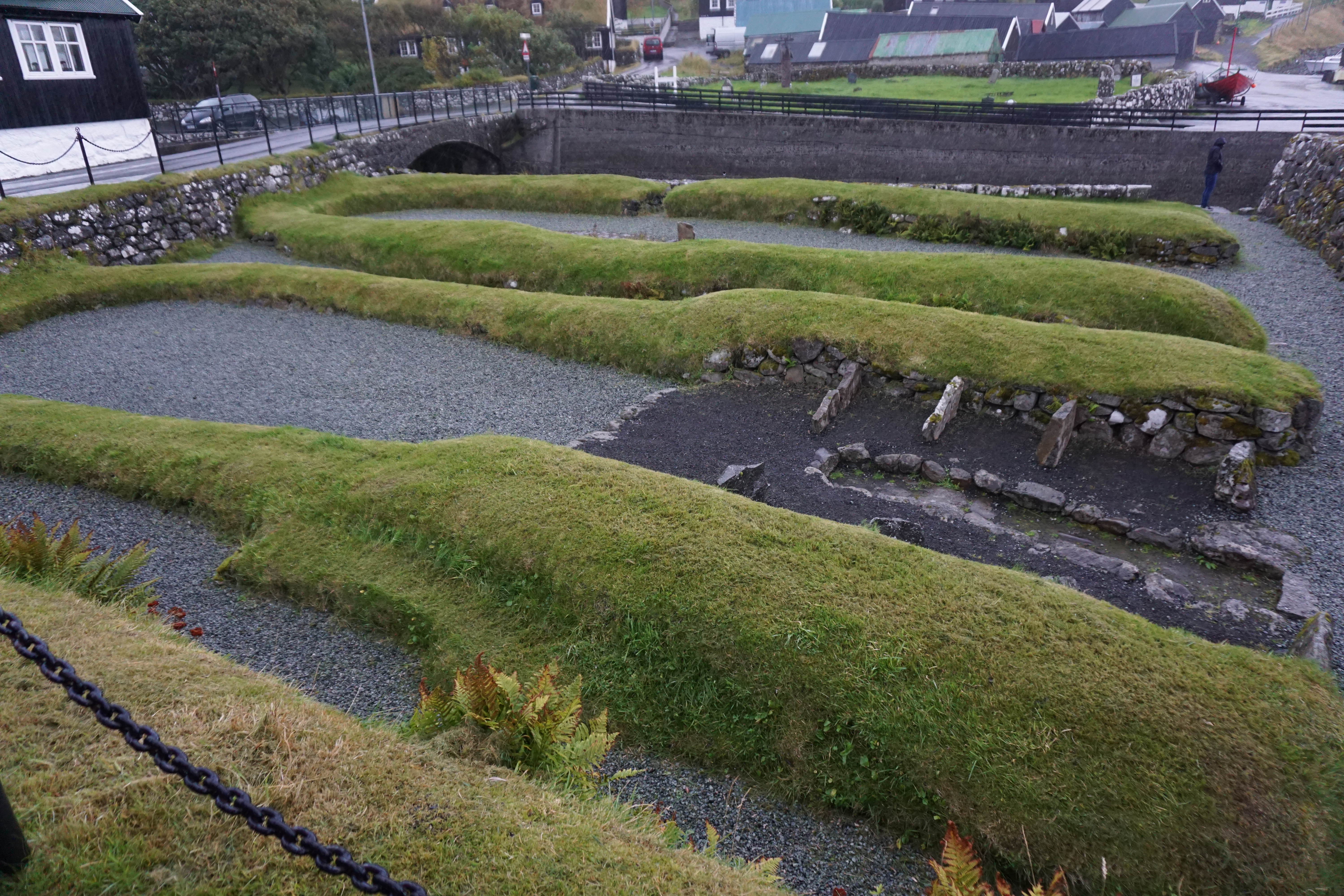
The Viking settlement at Kvivik. Jennifer Billock
Even though the name for the Faroe Islands themselves, Føroyar, is derived from the Viking Old Norse language, they actually weren’t the first to find the region. “The Islands were founded by Irish monks,” Gunnar, a tour guide on the main island Streymoy, told Smithsonian.com. “Then the Vikings came and suddenly there were no more monks.” The Vikings arrived in the 9th century and quickly established a parliamentary meeting site at the tip of what is now the capital city, Tórshavn.
That spot in the city is now known as Old Town, known worldwide for its red buildings with turf roofs and cobblestone streets. Coincidentally, the Faroese parliament still meets in these buildings, giving Tórshavn the distinction of being the oldest functioning parliament in the world. Don’t miss the Viking-carved compass rose and runes at the end of Old Town’s rocky peninsula, right by the flag pole.
What to see: From the Faroe Islands’ capital Tórshavn, it’s an easy drive to seaside Kvívík, where you can find a 10th-century Viking settlement. The ruins are right in the middle of the village—also one of the oldest villages in the Islands—and contain longhouse and barn foundations. The southern end of the site has been washed away by the sea.
Iceland
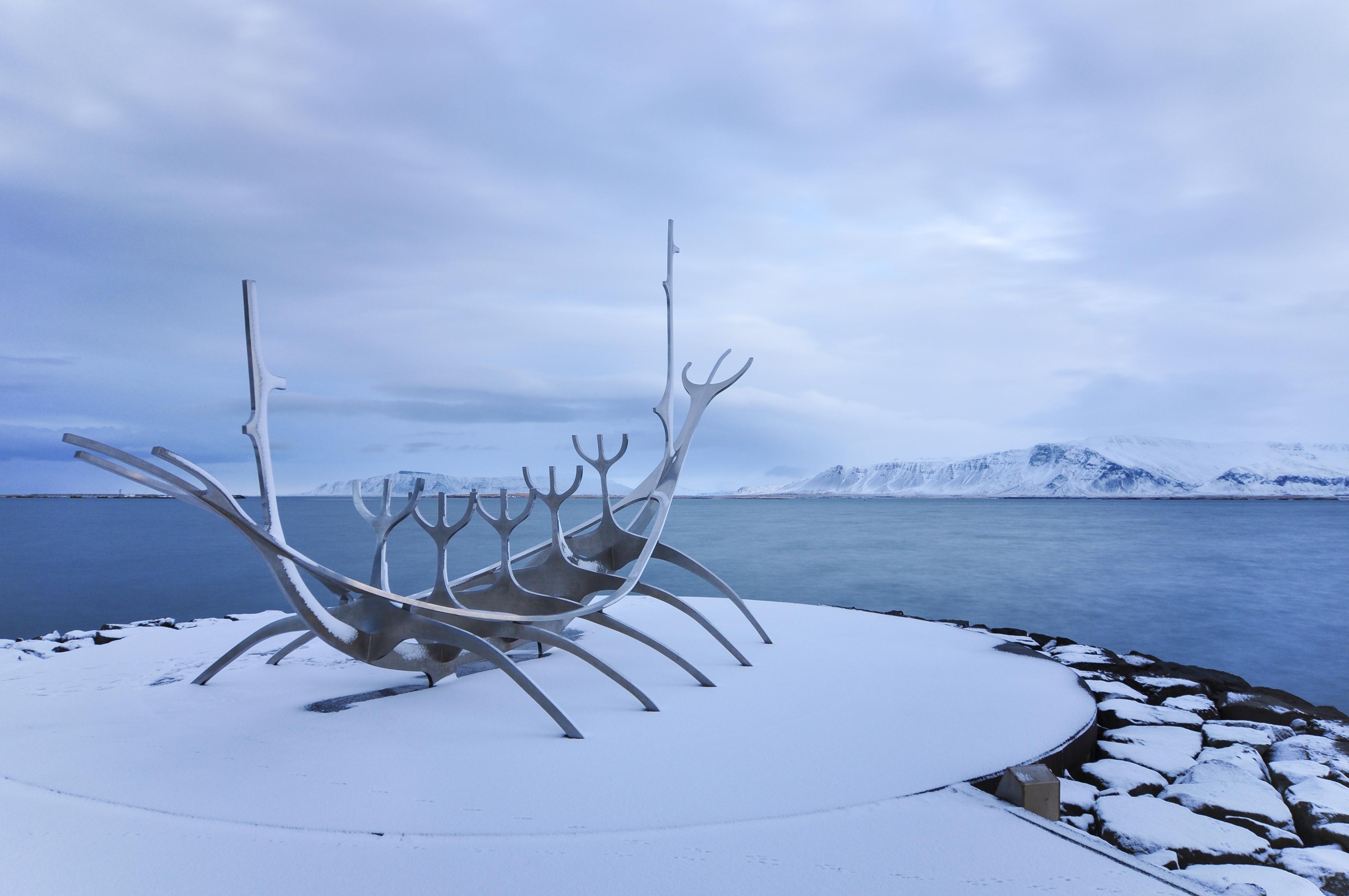
“Sun Voyager,” a sculpture by Jón Gunnar Árnason, in Reykjavík, Iceland. tailiwei / iStock
Vikings settled in Iceland’s capital city, Reykjavik, in the 800s. They let the gods decide exactly where they should settle by floating a wooden chair across the water from one of the longboats: wherever the chair landed, the city should be. By 900 AD, Goodness said, more than 24,000 people lived there. It was a time of peace for the plundering Vikings.
“Iceland was considered a paradise for the settlers,” Goodness said. “Because of the pillaging and raiding, they started to be met with resistance. You can only maraud a place so many times before people [start] fighting back. The Vikings saw that and thought, people are dying, this isn’t fun anymore. They weren’t really interested in fighting anymore. It was time for them to live peacefully. This was a great period of transition for them in Iceland.”
Today, more than 60 percent of Icelanders are Norse, and the rest are mostly of Scottish or Irish heritage, many of their ancestors having been brought to Iceland as slaves by the Vikings.
What to see: Traces of Viking heritage are all over Iceland—the country even has a Viking trail you can follow—but for a good look, head to the Settlement Museum in downtown Reykjavik. Here, ruins of a Viking settlement are preserved in an underground exhibit. And across the hall from the longhouse, ancient saga manuscripts are also on display.
Greenland
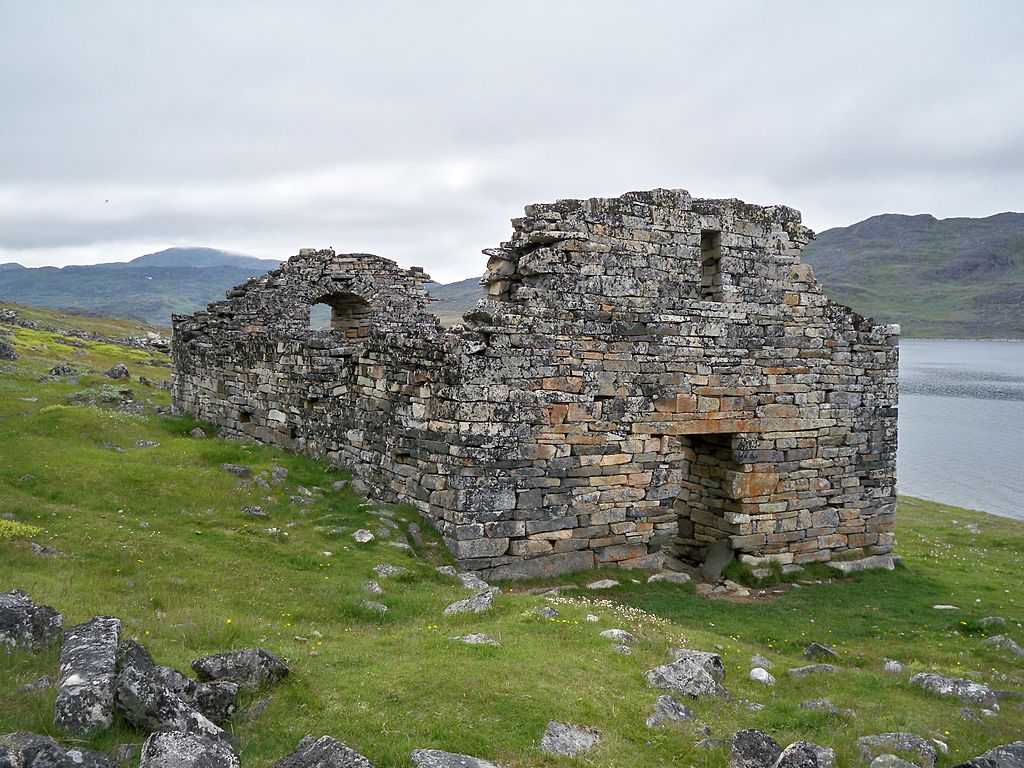
Hvalsey Church. Creative Commons
In 982, Erik the Red committed a murder in Iceland and was exiled for three years as a result. He sailed off to the west, finding Greenland and spending his time in exile there. During that time, Goodness says, Greenland may actually have been green, covered with forests and vegetation, as the Viking would have landed during the Medieval Warm Period (believed to be about 900 to 1300) when sea ice decreased and crops had longer to grow. After his sentence ended, Erik the Red sailed back to Iceland to convince other settlers to follow him to this new promised land. In 985, he and a fleet of 14 longships arrived to settle the southern and western coasts.
The Vikings continued to live on Greenland for about 500 years. Remains of Erik the Red’s settlement date back to about the year 1000, along with ruins of around 620 farms. At peak population, the Norse numbered around 10,000 people in the country. And then, suddenly, the community vanished with no explanation and no written record explaining why. However, historians have ultimately been able to explain it: “It was too hard to live in Greenland and they got tired of it,” Goodness said. “They thought it was better to leave than stay in such a harsh climate.” Over time, the temperature was getting colder so farms were no longer workable, and the Vikings never learned to effectively hunt the region. The Inuit were inhospitable; fights broke out frequently. At the same time, Norway had been stricken by the plague, so many farmsteads there were left abandoned. A group of the Greenland settlers was known to have headed back to Norway to take over the land, and another sailed onward to Canada.
What to see: Hvalsey Church is the best-preserved Viking ruin in Greenland. Most people choose Qaqortoq as their base for trips to see the church. It appears to have been built around 1300, and only the stone walls remain. Hvalsey has a unique history itself, as well—in 1408, a wedding was held at the church, with many Norse attendees. The written account of that event is the last word that ever came from Greenland’s Viking population.
Canada
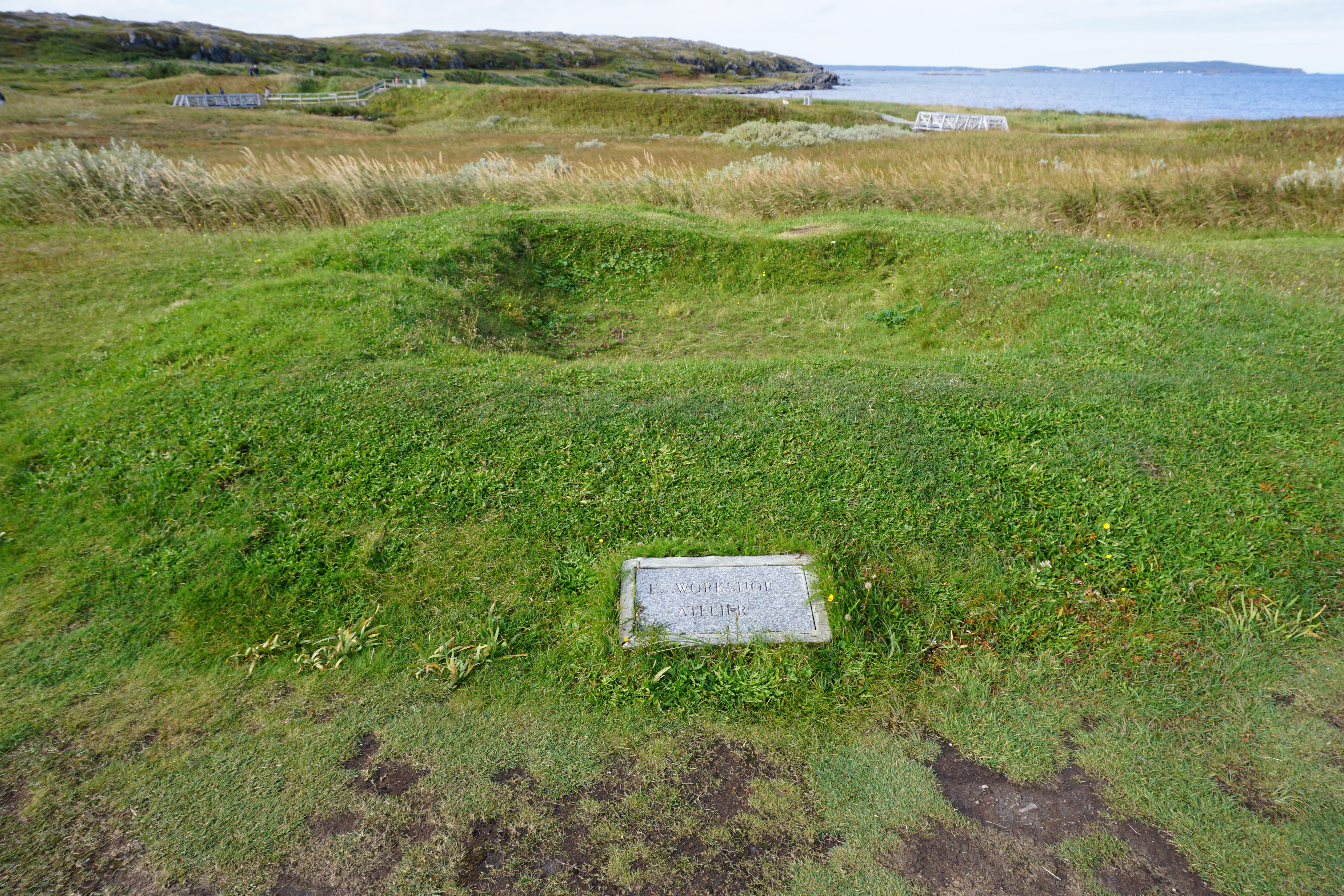
A workshop at the L’Anse Aux Meadows Viking settlement. Jennifer Billock
To see the first Viking settlements in North America—found 500 years before Christopher Columbus set foot there—head to L’Anse Aux Meadows. The Vikings first arrived here from Greenland in the late 10th century, led by Leif Erikson. He initially called the land Vinland (though the exact location of Vinland is disputed), because when the Vikings arrived they found grapes and vines. Spurred by Erikson’s success, more than 100 Vikings followed to settle at this spot. Prior to its discovery in the 1960s, this North American settlement was only referenced in two ancient sagas.
What to see: The archaeological site at L’Anse Aux Meadows has two main components: the actual ruins (visitors can stand inside the foundation of Leif Erikson’s own house) and a recreated Viking trading port nearby called Norstead. Here, you’ll see a unique juxtaposition of what life was believed to have been like for the Vikings and what rubble remains today.

Jennifer Billock is an award-winning writer, bestselling author, and editor. She is currently dreaming of an around-the-world trip with her Boston terrier. Check out her website at jenniferbillock.com.
Source https://www.ancient-origins.net/unexplained-phenomena/vikings-south-america-0013694
Source https://www.smithsonianmag.com/travel/visit-viking-settlement-sites-180965257/
Source